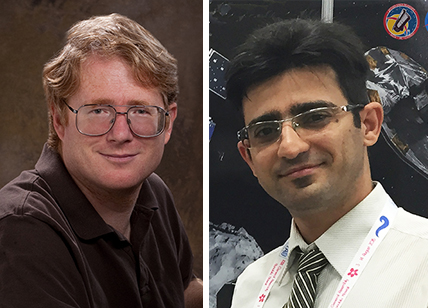U of A Astrophysicists Discover Mechanism for Spiral-Arm Formation in Disk Galaxies
FAYETTEVILLE, Ark. – Astrophysicists at the University of Arkansas have discovered a mechanism for the formation of the spiral arms in disk galaxies.
The finding was published in The Astrophysical Journal Letters, the journal of the American Astronomical Society.
The discovery provides a better understanding for the formation of spiral arms in a kind of disk galaxy known as a spiral galaxy, said Hamed Pour-Imani, a physics doctoral student at the U of A and lead author of the study.
Spiral arms are the elongated and curved spiral sections that are connected to the center of a spiral galaxy, such as our own Milky Way.
“Spiral galaxies are fascinating structures in astronomy, and the exact mechanism of the formation of spiral arms is still a mystery in astrophysics,” Pour-Imani said. “Our work provides strong evidence for the density wave theory of spiral galaxies, which is one of two popular theories to explain the spiral structures.”
Density wave theory was proposed in the 1960s to explain the spiral arm structure of spiral galaxies. The theory posited that spiral arms are not material in nature, but instead made up of areas of greater density, similar to a traffic jam on the highway. Stars move in and out of the spiral arms as they orbit the galaxy. The density wave theory predicts that the pitch angle of spiral arms should vary with the wavelength of the galaxy’s image.
Previous research either failed to find any significant variation in pitch angle or only limited evidence for it, Pour-Imani said. In this study, U of A astrophysicists used an optical wavelength image for disk galaxies and images from the NASA Spitzer Space Telescope at two infrared wavelengths. The pitch angles agreed with the density wave theory.
Pour-Imani is a member of the member of astrophysics research group led by Daniel Kennefick, associate professor in the Department of Physics and faculty member in the Arkansas Center for Space and Planetary Sciences.
The results were obtained through a collaboration that included Julia Kennefick, associate professor of physics and the space and planetary sciences center; Benjamin L. Davis, a U of A space and planetary sciences graduate who is now a postdoctoral fellow at the Swinburne University of Technology in Melbourne, Australia; and U of A doctoral students Douglas W. Shields and Mohamed Shameer Abdeen.
The research included the use of the NASA/IPAC Extragalactic Database, which is operated by the NASA Jet Propulsion Laboratory at the California Institute of Technology.
Topics
Contacts
Hamed Pour-Imani, doctoral student
Department of Physics
479-575-7634,
hpourima@uark.edu
Chris Branam, research communications writer/editor
University Relations
479-575-4737,
cwbranam@uark.edu
Headlines
Affairs of the Heart
Find out how biomedical engineering professor Morten Jensen is developing innovative devices to produce better outcomes in cardiovascular medicine.
Students, Faculty and Alumni Kick Off Centennial Year of School of Law
Founded April 14, 1924, the School of Law faculty, students and alumni started the celebration of its centennial year with a Founders Day event and will continue with more commemorative events this coming fall.
Yearly Academic Award Winners, Ambassadors Recognized by Bumpers College
Schyler Angell, Lexi Dilbeck, Cason Frisby, Tanner Austin King, Anna Brooke Mathis, Carrie Ortel, Lucy Scholma, Kadence Trosper and student ambassadors were honored at the college's annual reception.
World Premiere of 'Cries from the Cotton Field' Slated for May 8
Cries from the Cotton Field chronicles the journey of 19th century Italian immigrants from northern Italy to the Arkansas Delta and ultimately to Tontitown. It will premier at 6 p.m. May 8 in Springdale Har-Ber High School.
Fay Jones School's Earth Day Event Spotlights Sustainable Materials and Projects
"One day doesn't seem like a lot, but one day can empower individuals and groups, energize them to work for change and innovate for transformative solutions," professor Jennifer Webb said of the students' design work.





